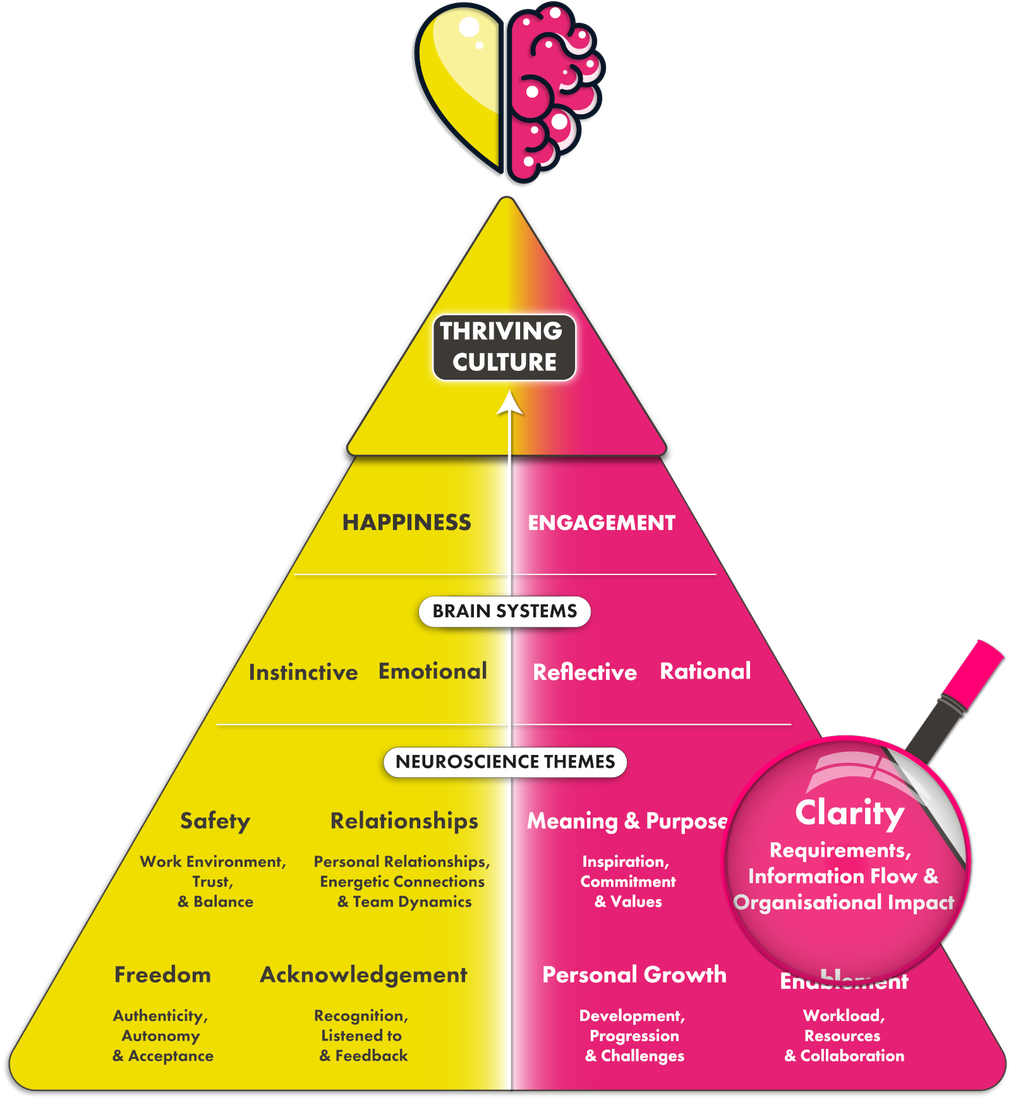
Neuroscience Deep Dive: Understand The Impact of Information Flow on Employee Engagement
Understanding how our own role fits into the wider flow of the company can be linked to employee engagement. Organisational impact is associated with the Rational brain system in our neuroscience model.
If you've just landed here, we recommend heading over to our brain systems and neuroscience themes pages for an introduction to our neuroscience model and methodology. Otherwise, read on to find out why organisational impact is a vital component for workplace engagement.
Lack of clarity causes a lack of productivity, confusion, and stress for many people. It can be a source of chaos or confusion that can send people in different directions. If people would rewind and actually look at clarity as the starting point, such as What are we doing? What problem are we trying to solve? It would save a lot of heartache down the line. When people have more clarity, they can see the bigger organisational picture and how they fit into the wider process. The flow of the end-to-end business encourages cross-functional consideration and ideas, avoiding missed opportunities, confusion, and frustration.

Organisations are constantly changing, so the question becomes how often we should be seeking to re-clarify information or acknowledging when clarity has changed and needs to be redefined or updated. If we believe something has stayed the same, we’ll most likely be caught off guard when we realise a change has happened. So, it’s important to check in with what is changing so that you know when clarification may need to be updated.
Just because one person has clarity on something doesn’t mean that clarity is the same for everyone across the organisation. There are caverns of communication that need to be done, not just once but over and over, so that there's continuous agreement on what clarity is. Often the lack of charity comes when two people believe they have shared clarity, but really it’s different versions of the truth. We create the perception of the clarity we want. So there is a reality of what clarity is, and then there's what you communicate it to be. Effective communication, as well as understanding how people perceive the information is a nuance that can't be ignored.
When someone is applying for a position, the applicant’s clarity of what the role means, in reality, doesn't kick in until they are able to understand the culture and meet the rest of the organisation. Perspective is important to consider. Clarity can be under a microscope for some things, while in other areas, it's a piece of a jigsaw. You can't have clarity until you have those other pieces. However, once you zoom out and have all the pieces, you will be able to see the full picture.
With the busyness and distractions of everything in our workplaces, there is no guarantee people are receiving all the information, so you have to communicate multiple times so that it will land with your full audience. Keep it simple, have sound bites that follow up or a program of communication. Include several avenues for employees to express themselves, whether that is town halls or through Slack channels where there are various groups that can spontaneously start conversations. This will suit different people who respond and engage with information in different ways.
Share information in a way that suits you; otherwise, you’ll lose any authenticity. In order to move to certain channels or force ways of communicating, you lose the impact of your message, regardless of how simple, so choose communication styles that will keep your voice in the way that’s authentically you.
Good leadership means connecting with your people. According to HBR, organisations need leaders who care and truly want to connect with employees to learn and understand what they really want and need to perform their jobs. If you have hands-off leadership, this will be a little bit robotic and may not lead to proper answers. Open channels of communication so employees can share regularly rather than just when something goes amiss. This will allow leaders to explain what they are doing and reflect on feedback (good and bad) so people can see the journey. This will create an environment where people know they can speak out and their leaders actually care about and listen to them. Use data tools like the Happiness Index to measure where the organisation is currently and to uncover problems that are below the surface that people may not be aware of.
People have to be told things consistently and many times for them to get full clarity. If you're changing your story every time, it will create a lack of clarity. Continue to keep it simple, narrow it down to a few things, and don’t overload the information flows. There are chances that communication is regular, but it’s far too much information, so it doesn’t translatable to everyone in every part of the organisation. The key point is to frequently and continuously invite people to share and be part of the conversation so you can rely on their feedback when you need it and not just when things are going well.
*This is an excerpt from the Happiness and Humans Podcast with Fiona McDonnell, Author and CV of Commerical Operations at Booking.com. Click here to listen to the full podcast.

Linked to Engagement in our neuroscience methodology... learn more
The Happiness Index helps organisations measure the key employee engagement AND happiness drivers to power their people strategy.
Our unique platform offers the products, insights and tools to shine a light on your cultural health and empower management to drive thriving cultures.
Our neuroscience-based pre-built surveys measure the full employee experience - from onboarding to exit to empower and enable organisations to understand their people and create data-led action plans.
